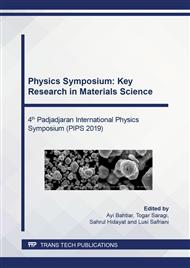[1]
K. Liu, Y. Liu, D. Lin, A. Pei, Y. Cui, Materials for lithium-ion battery safety, Sci. Adv. 4 (2018) 9820.
Google Scholar
[2]
O. Toprakci, H.A.K. Toprakci, L.Ji, X. Zhang, Fabrication and electrochemical characteristics of LiFePO4 powders for lithium-ion batteries, KONA Powder Part. J. 28 (2010) 50–73.
DOI: 10.14356/kona.2010008
Google Scholar
[3]
A. Ritchie, W. Howard, Recent developments and likely advances in lithium-ion batteries, J. Power Sources 162 (2006) 809–812.
DOI: 10.1016/j.jpowsour.2005.07.014
Google Scholar
[4]
N. Kamarulzaman, Z. Osman, M.R. Muhamad, Z.A. Ibrahim, A.K. Arof, N.S. Mohamed, Performance characteristics of LiMn2O4/polymer/carbon electrochemical cells, J. Power Sources 97–98 (2001) 722–725.
DOI: 10.1016/s0378-7753(01)00647-4
Google Scholar
[5]
N.B.A. Hamid, Cathode materials produced by spray flame synthesis for lithium ion batteries, PhD Dissertation, University of Duisburg-Essen, Germany (2013).
Google Scholar
[6]
A.K. Padhi, Phospho-olivines as positive-electrode materials for rechargeable lithium batteries, J. Electrochem. Soc.144 (1997) 1188.
DOI: 10.1149/1.1837571
Google Scholar
[7]
C. Gong, Z. Xue, S. Wen, Y. Ye, X. Xie, Advanced carbon materials/olivine LiFePO4 composites cathode for lithium ion batteries, J. Power Sources 318 (2016) 93–112.
DOI: 10.1016/j.jpowsour.2016.04.008
Google Scholar
[8]
R. Amin, C. Lin, J. Peng, K. Weichert, T. Acartürk, U. Starke, J. Maier, Silicon-doped LiFePO4 single crystals: Growth, conductivity behavior, and diffusivity, Adv. Funct. Mater. 19 (2009) 1697–1704.
DOI: 10.1002/adfm.200801604
Google Scholar
[9]
J.-W. Zhao, S.-X. Zhao, X. Wu, H.-M. Cheng, C.-W. Nan, Double role of silicon in improving the rate performance of LiFePO4 cathode materials, J. Alloys Compd. 699 (2017) 849–855.
DOI: 10.1016/j.jallcom.2016.12.430
Google Scholar
[10]
J. Wang, Z. Shao, H. Ru, Influence of carbon sources on LiFePO4/C composites synthesized by the high-temperature high-energy ball milling method, Ceram. Int. 40 (2014) 6979–6985.
DOI: 10.1016/j.ceramint.2013.12.025
Google Scholar
[11]
G. T.-K. Fey, Y. G. Chen, H.-M. Kao, Electrochemical properties of LiFePO4 prepared via ball-milling, J. Power Sources 189 (2009) 169–178.
DOI: 10.1016/j.jpowsour.2008.10.016
Google Scholar


